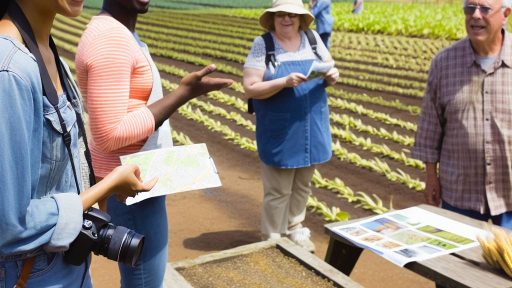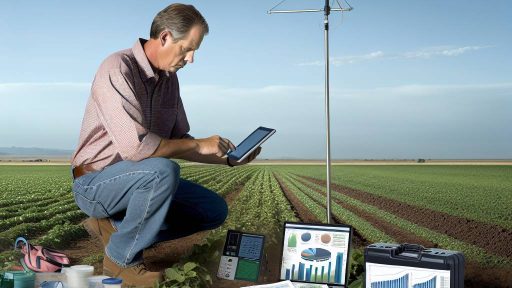Identifying Target Audiences for Agritourism
Understanding Your Market
Identifying your target audience is crucial for agritourism success.
Begin by researching demographics in your area.
Consider factors like age, income, and interests.
Additionally, explore visitation patterns to gain insights.
Segmenting Your Audience
Breaking your audience into segments can enhance marketing efforts.
For instance, families often seek educational experiences.
Couples might look for romantic getaways on farms.
Moreover, school groups may seek hands-on learning opportunities.
Identifying these segments will tailor your marketing messages.
Creating Targeted Marketing Strategies
Once you understand your audience segments, craft tailored strategies.
Utilize social media to reach younger audiences effectively.
Offer family packages during school holidays to attract families.
Business-focused events can target local corporate groups.
Consider partnerships with local hotels to attract tourists.
Gathering Feedback and Adapting
Collect feedback from visitors to refine your strategies.
Transform Your Agribusiness
Unlock your farm's potential with expert advice tailored to your needs. Get actionable steps that drive real results.
Get StartedSurveys after visits provide valuable information about preferences.
Use this data to adjust offerings and improve experiences.
Regularly update your target audience profiles based on trends.
Utilizing Data Analytics
Data analytics can enhance your understanding of customer behavior.
Track online engagement and booking patterns on your website.
Analyze social media interactions to assess audience interests.
This data informs targeted marketing efforts for future seasons.
Building a Unique Brand Identity for Your Agritourism Business
Defining Your Brand’s Core Values
Start by identifying your agritourism values.
Core values guide your business decisions.
Consider what makes your farm special.
Emphasize sustainability, community, or quality produce.
Crafting a Memorable Brand Story
Share the history behind your agritourism venture.
Engage customers with a relatable narrative.
Describe your journey from farm to table.
Highlight unique experiences available on your farm.
Designing a Captivating Visual Identity
Create a logo that reflects your farm’s essence.
Use colors and fonts that evoke your brand personality.
Ensure your visual elements are consistent across platforms.
Apply this design in signage, packaging, and online presence.
Delivering an Exceptional Customer Experience
Focus on creating memorable experiences for guests.
Enhance customer interactions with friendly service.
Offer guided tours and hands-on activities.
Consider seasonal events to keep visitors engaged.
Utilizing Social Media to Build Your Brand
Leverage social media platforms for exposure.
Showcase Your Farming Business
Publish your professional farming services profile on our blog for a one-time fee of $200 and reach a dedicated audience of farmers and agribusiness owners.
Publish Your ProfileShare engaging content about your farm and events.
Connect with your audience through stories and posts.
Encourage user-generated content and testimonials.
Building Partnerships within the Community
Collaborate with local businesses to strengthen your brand.
Partner with restaurants to showcase your products.
Engage with local organizations for community events.
These alliances enhance your brand visibility and credibility.
Utilizing Social Media for Effective Marketing Outreach
Understanding the Power of Social Media
Social media platforms serve as vital marketing tools.
They help businesses connect with potential customers.
Moreover, these platforms allow for direct engagement.
With billions of users globally, the reach is substantial.
Businesses should utilize this reach strategically.
Selecting the Right Platforms
Choosing the correct social media platform is crucial.
Identify where your target audience spends time.
For instance, Instagram appeals to younger demographics.
On the other hand, Facebook attracts a broader age range.
For B2B companies, LinkedIn proves more effective.
Thus, select platforms aligned with your goals.
Creating Engaging Content
Content quality significantly affects engagement rates.
Visual content such as images and videos captures attention.
Additionally, storytelling creates emotional connections.
Regularly share updates and behind-the-scenes glimpses.
Also, using polls and questions encourages interaction.
Building a Community
Social media fosters community building effectively.
Engage with followers by responding to comments.
Encouraging user-generated content enhances authenticity.
Create contests or giveaways to increase participation.
Recognize and highlight your loyal customers regularly.
Monitoring and Analyzing Performance
Monitoring performance helps refine your strategy.
Utilize analytics tools to track engagement metrics.
Assess post reach and audience interactions frequently.
This data informs future content creation efforts.
Continuously adapting based on insights maximizes effectiveness.
Delve into the Subject: Precision Agriculture Tools To Reduce Operational Costs
Creating Engaging Content for Your Agritourism Website
Understanding Your Audience
Start by identifying your target audience clearly.
Knowing your audience shapes the content you create.
Consider their interests, preferences, and common questions.
Incorporate this understanding into your website strategy.
Showcasing Unique Experiences
Highlight the unique features of your agritourism business.
Use vivid descriptions to paint a picture in visitors’ minds.
Showcase Your Farming Business
Publish your professional farming services profile on our blog for a one-time fee of $200 and reach a dedicated audience of farmers and agribusiness owners.
Publish Your ProfileInclude personal stories that residents or visitors can relate to.
Additionally, showcase seasonal activities to attract returning guests.
Utilizing High-Quality Visuals
Invest in high-quality imagery to showcase your offerings.
Images can captivate visitors and enhance your message.
Consider incorporating videos to convey experiences more effectively.
Visuals should complement your text and enhance the overall presentation.
Optimizing for Search Engines
Implement strong SEO practices to improve visibility online.
Use relevant keywords throughout your content effectively.
Structure your content with proper headers for search optimization.
Regularly update your website to keep it fresh and engaging.
Providing Useful Information
Include a blog section with helpful articles related to agritourism.
Offer tips for visitors on what to bring, how to prepare, and what to expect.
Additionally, create guides that highlight local attractions and events.
This positions you as a trusted resource in the agritourism community.
Encouraging User Interaction
Engage your visitors by encouraging comments and questions.
Consider adding a FAQ section based on common inquiries.
Utilize social media platforms to foster community interaction.
This approach can build loyal customer relationships and encourage sharing.
Implementing Calls to Action
Strategically place calls to action throughout your website.
Encourage visitors to book a tour, sign up for a newsletter, or follow you online.
Clear, direct language helps guide visitors toward making decisions.
Regularly review the effectiveness of these calls to action.
Discover More: Sustainable Diversification Methods for Contemporary Farmers
Developing Partnerships with Local Businesses and Organizations
The Importance of Local Partnerships
Local partnerships enhance community engagement and visibility.
They create a network of resources for agritourism businesses.
Working together fosters a sense of community and support.
Identifying Potential Partners
Evaluate businesses that share a similar target audience.
Consider farms, wineries, breweries, and restaurants.
Local accommodations, such as inns and bed-and-breakfasts, can also be excellent partners.
Creating Collaborative Promotions
Joint marketing campaigns attract more visitors to the area.
For example, a local winery and farm could host a seasonal festival.
This type of event showcases both entities and encourages visitor spending.
Establishing Cross-Promotion Opportunities
Use social media to promote each other’s offerings.
Feature partner businesses in newsletters and website content.
By creating a referral system, partners can drive new customers to each other.
Engaging with Community Organizations
Connect with local tourism boards and chambers of commerce.
These organizations often help promote agritourism initiatives.
They can provide valuable resources and advertising opportunities.
Building Long-Term Relationships
Consistency in partnership interactions fosters trust and reliability.
Regular meetings can help partners align their goals and strategies.
Showcase Your Farming Business
Publish your professional farming services profile on our blog for a one-time fee of $200 and reach a dedicated audience of farmers and agribusiness owners.
Publish Your ProfileAlways communicate openly about challenges and successes.
You Might Also Like: Creating Memorable Farm Stays To Boost Agritourism Appeal

Leveraging Seasonal Events and Festivals to Attract Visitors
Understanding the Importance of Seasonal Events
Seasonal events create excitement and draw visitors to agritourism businesses.
These events can enhance visitor engagement significantly.
Moreover, they allow businesses to showcase their unique offerings.
Farmers markets, harvest festivals, and holiday celebrations attract diverse audiences.
Planning Effective Seasonal Events
Start by identifying key seasonal moments relevant to your location.
For instance, apple picking season creates a great opportunity in the fall.
Next, consider local holidays and traditions that could align with your activities.
Involve the community to enhance local involvement and attendance.
Promoting Your Seasonal Events
Utilize social media to spread the word about your events.
Create engaging posts that highlight activities, offers, and experiences.
Additionally, use email marketing to inform past visitors of upcoming events.
Partner with local businesses for mutual promotion to increase reach.
Offering Unique Experiences During Events
Create themed activities that resonate with seasonal celebrations.
Consider hosting pumpkin carving contests in the fall.
Offer guided farm tours to educate visitors about your practices.
Unique experiences can turn casual visitors into loyal customers.
Gathering Feedback and Making Improvements
After each event, collect feedback from attendees for future improvements.
Surveys can help identify what worked well and areas needing enhancement.
Adapt your strategies based on visitor input to increase satisfaction.
Continuous improvement will keep visitors returning year after year.
Find Out More: Essential Record Keeping Practices To Ensure Farm Financial Success
Implementing Email Marketing Campaigns for Customer Engagement
Establishing Your Email List
Building a strong email list is essential for agritourism businesses.
Begin by collecting emails during farm visits or events.
Offer incentives, such as discounts or exclusive content, to encourage sign-ups.
Utilize social media platforms to promote your email newsletter.
Creating Compelling Content
Email marketing should focus on providing value to your subscribers.
Share updates about upcoming events and attractions at your farm.
Include behind-the-scenes stories to engage your audience.
Utilize eye-catching images to capture attention.
Always personalize your content to make it relatable.
Segmenting Your Audience
Segmentation enhances the effectiveness of your email campaigns.
Group contacts based on their interests or past visits.
Send targeted emails that address specific preferences and behaviors.
This approach increases engagement and customer loyalty.
Timing and Frequency of Campaigns
Choose the right timing for sending your emails.
Consider sending newsletters during peak planning seasons.
Maintain a consistent frequency to keep your audience engaged.
Avoid overwhelming your subscribers with excessive emails.
Showcase Your Farming Business
Publish your professional farming services profile on our blog for a one-time fee of $200 and reach a dedicated audience of farmers and agribusiness owners.
Publish Your ProfileAnalyzing Campaign Performance
Regularly assess the performance of your email campaigns.
Focus on open rates, click-through rates, and conversion rates.
Use analytics to identify which content resonates with your audience.
Adjust your strategies based on these insights for improvement.
Encouraging Feedback and Interaction
Invite recipients to share their feedback through surveys.
Engage your audience by asking for their opinions on events or products.
Incorporate user-generated content to boost community involvement.
This interaction fosters a sense of belonging among your customers.
Measuring and Analyzing Marketing Efforts to Optimize Strategies
Importance of Measurement
Measuring marketing efforts is crucial for any agritourism business.
It helps identify what works and what does not.
Moreover, it allows businesses to allocate resources effectively.
Additionally, understanding audience engagement improves marketing tactics.
Establishing Key Performance Indicators
First, establish clear key performance indicators (KPIs).
These KPIs can include website traffic, social media engagement, and conversion rates.
Next, monitor these metrics regularly to gauge performance.
This practice allows quick adjustments based on real-time data.
Utilizing Analytics Tools
Leveraging analytics tools enhances data collection and analysis.
Google Analytics provides insights into user behavior and demographics.
Social media platforms offer analytics dashboards for engagement metrics.
Likewise, email marketing software tracks open and click-through rates.
Feedback Collection
Collecting feedback is vital for understanding customer sentiments.
Surveys and questionnaires can provide valuable qualitative data.
Engaging customers on social media also yields insightful feedback.
Furthermore, incorporating feedback helps refine marketing strategies.
Tracking Return on Investment
Tracking return on investment (ROI) is essential for assessing success.
Calculate ROI by comparing net profit to marketing costs.
Consistent tracking reveals the most effective marketing channels.
Consequently, this information aids in future budgeting and planning.
Adjusting Strategies
Regularly review analytics to determine necessary adjustments.
If certain campaigns underperform, consider changing the approach.
Testing different strategies can lead to improved results.
Remain flexible and open to new ideas and methods.
Case Studies and Best Practices
Examining successful agritourism businesses can provide valuable insights.
For instance, Maple Lane Farms increased revenue through targeted ads.
They analyzed data and refined their messaging based on customer preferences.
Similarly, Sunny Acres implemented feedback loops to enhance customer experience.
Continuous Evaluation and Strategy Advancement
Measuring and analyzing marketing efforts drive strategic improvements.
Continuous evaluation ensures alignment with business goals.
Moreover, forward-thinking strategies keep agritourism businesses competitive.
Embrace data-driven decisions to foster sustainable growth.
Showcase Your Farming Business
Publish your professional farming services profile on our blog for a one-time fee of $200 and reach a dedicated audience of farmers and agribusiness owners.
Publish Your ProfileAdditional Resources
IDB Study Advocates for Agribusiness Transformation in Latin … – IDB
Agritourism: A Strategic Pathway for Development in Central …




